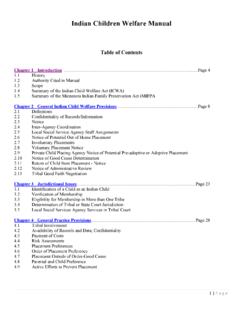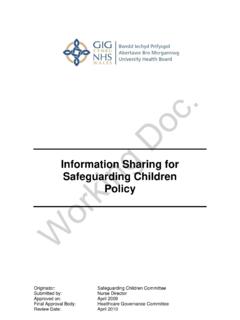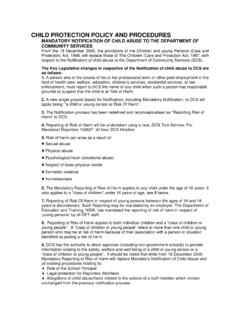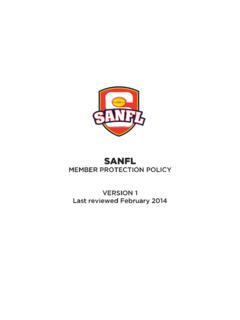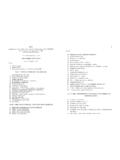Transcription of DHS-Pub-215, Human Trafficking of Children Protocol
1 Human Trafficking of Children Protocol Michigan Department of Health and Human Services Revised: November 2017. Table of Contents Committee Members .. 2. I. Introduction .. 4. II. Michigan Law Related to Child Trafficking .. 5. A. Child Sex Trafficking .. 5. B. Child Labor 6. C. Basis for Family Court Jurisdiction .. 7. 1. Dependency 7. 2. Traditional Abuse and Neglect Jurisdiction .. 8. D. Special Considerations for Missing Children under the Preventing Sex Trafficking and Strengthening Families Act .. 9. III. Identifying Victims of Human Trafficking .. 9. A. Sex Trafficking Indicators .. 10. 1. Environmental Indicators .. 10. 2. Physical Indicators .. 10. 3. Medical Indicators .. 11. 4. Other Indicators .. 11. B. Labor Trafficking 11. 1. Environmental Indicators .. 11. 2. Physical Indicators .. 11. 3. Medical Indicators .. 11. 4. Other Indicators .. 12. C. The Human Trafficking Screening Tools .. 12. D. Youth with Closed Foster Care 13.
2 IV. CPS Investigation and Coordination with Law Enforcement .. 13. A. Interviewing the Child .. 14. 1. Determining When to Use a Screening Tool .. 14. 2. Conducting the Interview .. 14. B. Taking a Child into Protective 15. C. Appropriate Placement and Treatment .. 15. D. Foreign Nationals .. 16. E. American Indian/Alaska Native Children .. 17. F. Addressing the Victim's Medical and Mental Health Needs .. 17. 1. Medical Evaluation .. 17. 2. Psychological Assessment or Evaluation .. 18. V. Conclusion .. 18. 1. Committee Members Colin Parks Chair of the Committee Manager Children 's Protective Services Michigan Department of Health and Human Services Angela Aufdemberge Kelly Carter President and Chief Executive Officer Assistant Attorney General Vista Maria Michigan Department of Attorney General Allison Beckman Sarah Goad Departmental Analyst Manager Foster Care Program Policy Foster Care and MiTeam Model Michigan Department of Health and Human Michigan Department of Health and Human Services Services Jonathan Breems Robert Harvey Departmental Analyst Human Trafficking Analyst Policy and Strategic Initiatives Education and Youth Services Unit Michigan Department of Health and Human Michigan Department of Health and Human Services Services Mary Brennan Elizabeth Hertel Manager and Regulatory Affairs Officer Former Administration Director Bureau of Legal Affairs Policy.
3 Planning and Legislative Services Michigan Department of Health and Human Population Services Michigan Department of Health and Human Services Deborah Carley Susan Hull Division Chief Director Children and Youth Services Children 's Services Agency Michigan Department of Attorney General Oakland County Department of Health and Human Services Bridgette Carr Janet Kaley Clinical Professor and Director Manager Human Trafficking Clinic Education and Youth Services Unit University of Michigan Law School Michigan Department of Health and Human Services 2. Nancy Keller Annie Ray Section Manager, Western Wayne District Director Children 's Services Agency Children 's Services Agency Wayne County Department of Health and Wayne County Department of Health and Human Services Human Services Julie Knop Meredith Reese Director Vice President Treatment Programs Child Abuse Training Services Vista Maria Prosecuting Attorneys Association of Michigan David Manville Emily Schuster-Wachsberger Pre-Bachelor of Social Work Advisor and Local Council Coordinator Lecturer Children 's Trust Fund Eastern Michigan University Michigan Department of Health and Human Services Kelcy McArthur Stacey Tadgerson Departmental Analyst Director Children 's Protective Services Native American Affairs Michigan Department of Health and Human Michigan Department of Health and Human Services Services Jeff Meaton Kelly Wagner Specialist Director Bureau of Legal Affairs Child Welfare Services Michigan Department of Health and Human State
4 Court Administrative Office Services Michigan Supreme Court Dr. Dena Nazer, Jennifer Wrayno University Pediatricians Business Service Center 5 Director Children 's Hospital of Michigan Children 's Services Agency Detroit Medical Center Michigan Department of Health and Human Services Jill Pierce Unaccompanied Refugee Minor Analyst Office of Refugee Services Michigan Department of Health and Human Services 3. I. Introduction Human Trafficking is a form of modern-day slavery in which people profit from the control and exploitation of others. Victims of Human Trafficking can include Children and adults. They can be citizens or foreign nationals, male or female. The victim's relationship to the trafficker may be that of a family member, intimate partner, acquaintance or stranger. Victims are frequently exploited by traffickers who prey on their hopes of improving their lives or the lives of their families. While Trafficking generally includes the manipulation of a victim into the commission of commercial sex or labor acts, the use of force, fraud or coercion is not always requisite to an individual's status as a Trafficking victim.
5 Because the inherent vulnerabilities of Children make them easier to exploit, Michigan law now offers them greater protections, effectively shielding them from prosecution for acts they committed while in the care of their traffickers. In January 2015, several changes in the law went into effect that impact how law enforcement, the court and the Michigan Department of Health and Human Services (MDHHS) respond to child Trafficking cases. Perhaps most importantly, any child who is sexually exploited for commercial purposes is now recognized as a victim of Human Trafficking , regardless of his or her ability to prove the existence of force, fraud or coercion. By creating a presumption of coercion in sex- Trafficking cases involving Children , Michigan law shields these Children from prosecution for committing commercial sex acts. In response to these changes, MDHHS and other stakeholders developed the revised Protocol to guide child welfare and other professionals in identifying and assisting Children who may be victims of Human Trafficking .
6 Michigan laws call for a specialized, victim-centered approach that focuses on the rehabilitation rather than the criminalization of Human Trafficking victims. This Protocol was developed to create a system for meeting the immediate physical and psychological needs of the victims and to ensure that, when responding to victims of Human Trafficking , child welfare professionals are focused on connecting victims with the services they need to escape enslavement and recover from exploitation, rather than the prosecution of criminal activity. For purposes of this guide, it is important to note that a child may be the victim of Human Trafficking even if the trafficker is not charged and/or prosecuted. In sum, this document provides best practices for determining whether a child is a victim of Human Trafficking and how to move forward once a child has been identified as a victim. The goals of the Protocol are to enable child welfare professionals to meet the immediate safety needs of Human 4.
7 Trafficking victims; their long-term needs for stabilization; and the successful return to a normal home setting. Whenever possible, these needs should be met through the use of a coordinated, investigative team approach that employs Child Advocacy Centers (CAC) and community services to minimize trauma to the victim while providing continued protection and the delivery of specialized services. A child manipulated into committing criminal activities should not lose his or her status as both a child and a victim, nor his or her need for special protection. MDHHS intends for this Protocol to promote a better understanding of the unique nature and challenges of cases involving child victims of Human Trafficking . II. Michigan Law Related to Child Trafficking A. Child Sex Trafficking Under Michigan law, any child who has been recruited, enticed, harbored, transported, provided, or obtained for commercial sexual activity, a sexually-explicit performance or the production of pornography, is a victim of sex Although traffickers often use force, threats, violence, false promises, manipulation, lies and other physical or psychological methods to control their victims, a child need only be sexually exploited to be considered a victim of sex Trafficking in Michigan.
8 For Children 16 years of age and older who are developmentally capable of consenting to sex the presumption is rebuttable, meaning that it can be overcome if the prosecution can prove beyond a reasonable doubt that the child was not forced or coerced into committing the Further, the presumption may be lost if the child refuses or fails to substantially comply with court-ordered In all cases involving Children under the age of 16, the presumption is absolute and the child's sexual conduct may not be criminalized. Examples of sexual exploitation include, but are not limited to, prostitution, performance of sexual acts on film or for a website, the psychological influence of Children through romantic relationships with their trafficker, or survival sex. Survival sex is defined as trading sex for money or shelter. The practice is common among teenagers and young adults who have few other viable means for meeting their basic food, clothing and shelter needs.
9 Thus, a child engaging in sexual acts may or may not be held in physical captivity. In fact, the likelihood of 1. MCL (6). 2. Id. 3. Id. 5. psychological captivity is much higher. For instance, a child may have been told by his or her trafficker that if he or she tells authorities about the trafficker's control, the trafficker will tell their family and friends of their sexual exploits. In other cases, a trafficker may cause a victim to believe that their trafficker is the only person who cares for him or her. Often the very characteristics that make a child vulnerable to Trafficking have been exploited by the child's trafficker. Recognizing these Children as victims is essential to the effectiveness of the new legal framework. Therefore, upon finding a child engaged in any commercial, sexual activity, law enforcement must immediately make a Children 's Protective Services (CPS) complaint to MDHHS through the statewide centralized intake Upon receipt, MDHHS must begin investigating the complaint as soon as possible, but within 24 The CPS investigation must include a determination as to whether the child is in danger of substantial physical or psychological harm and requires protective intervention, including the initiation of child protective or dependency proceedings.
10 (See explanation of dependency in Section Basis for Family Court Jurisdiction).6. B. Child Labor Trafficking Under Michigan law, any child who has been recruited, enticed, harbored, transported, provided or obtained for forced labor is a victim of labor Labor Trafficking can include, but is not limited to, domestic servitude, forced labor in restaurants or salons, forced agricultural labor or debt MDHHS' response to child labor Trafficking may differ from its response to child sex Trafficking . Under federal law, labor Trafficking victims must provide proof that force, fraud or coercion existed while they were in the care of their trafficker;. regardless if the victims are Children or adults. Michigan law included a provision that allows the identification of child victims of labor Trafficking , regardless of the presence of force, fraud or coercion, keeping these Children in line with sex Trafficking victims. Child labor traffickers sometimes utilize methods of child sex traffickers as a way to control victims.










